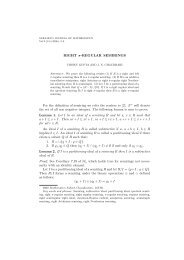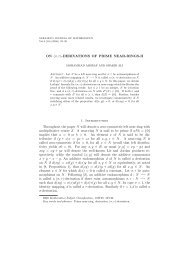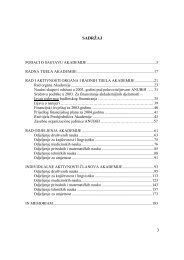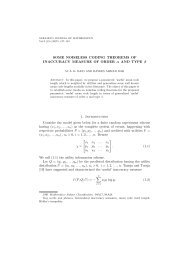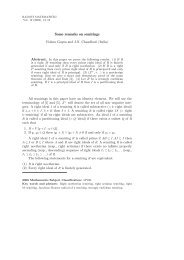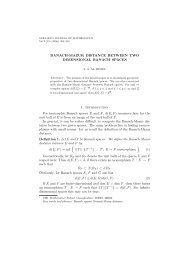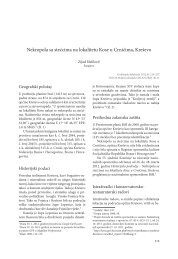OPEN PROBLEMS AND CONJECTURES ON RATIONAL ... - anubih
OPEN PROBLEMS AND CONJECTURES ON RATIONAL ... - anubih
OPEN PROBLEMS AND CONJECTURES ON RATIONAL ... - anubih
You also want an ePaper? Increase the reach of your titles
YUMPU automatically turns print PDFs into web optimized ePapers that Google loves.
SARAJEVO JOURNAL OF MATHEMATICSVol.8 (21) (2012), 311–321DOI: 10.5644/SJM.08.2.11<strong>OPEN</strong> <strong>PROBLEMS</strong> <strong>AND</strong> <strong>C<strong>ON</strong>JECTURES</strong> <strong>ON</strong> RATI<strong>ON</strong>ALSYSTEMS IN THREE DIMENSI<strong>ON</strong>SG. LADAS, G. LUGO <strong>AND</strong> F. J. PALLADINODedicated to Professor Mustafa Kulenović on the occasion of his 60 th birthdayAbstract. We present some open problems and conjectures on RationalSystems in three dimensions, or higher, with nonnegative parametersand with nonnegative initial conditions such that the denominators arealways positive. We also employ the method of Full Limiting Sequencesto confirm an outstanding conjecture on k th -order rational differenceequations.1. IntroductionIn this paper, we present some open problems and conjectures on rationalsystems in three dimensions of the form:x n+1 =α 1 + β 1 x n + γ 1 y n + δ 1 z nA 1 + B 1 x n + C 1 y n + D 1 z n⎫⎪y n+1 =α 2 + β 2 x n + γ 2 y n + δ 2 z ⎬n, n = 0, 1, . . . (1)A 2 + B 2 x n + C 2 y n + D 2 z nz n+1 =α 3 + β 3 x n + γ 3 y n + δ 3 z n ⎪ ⎭A 3 + B 3 x n + C 3 y n + D 3 z nwith nonnegative parameters and with nonnegative initial conditions suchthat the denominators are always positive.We also employ the method of Full Limiting sequences, see Theorem 1.8in [27], to confirm Conjecture 1, in Section 2, about the global character of2000 Mathematics Subject Classification. 39A10, 39A11.Key words and phrases. Difference equation, global asymptotic stability, boundednesscharacter, difference inequality, rational system.
312 G. LADAS, G. LUGO <strong>AND</strong> F. J. PALLADINOsolutions of the (k + 1) th -order rational difference equation :x n+1 =α1 + ∏ ki=0 x , n = 0, 1, . . . (2)n−iwhich is derived from a rational system in higher dimensions.A systematic work on the global character of rational systems in twodimensions of the form :x n+1 = α 1 + β 1 x n + γ 1 y nA 1 + B 1 x n + C 1 y ny n+1 = α 2 + β 2 x n + γ 2 y nA 2 + B 2 x n + C 2 y n⎫⎪ ⎬⎪ ⎭, n = 0, 1, . . . (3)was intitiated in [15]. Several special cases of system (3) have been investigatedby Kulenović and Merino and their students, and also by Ladasand his collaborators and students. See [1]-[3], [5]-[7], [9]-[21], [25], [28]-[29],[31]-[40]. See also: [4], [8], [22]-[23], [26], [30], [41]-[42], and [45].It is an amazing fact that system (1) contains,(2 4 − 1) × (2 4 − 1) × (2 4 − 1) × (2 4 − 1) × (2 4 − 1) × (2 4 − 1) = 11, 390, 625special cases of rational systems in 3 dimensions and it is of paramountimportance to understand the global character of solutions of each one ofthese special cases.2. Open problems and conjecturesHere we pose some open problems and conjectures on the global characterof solutions of System (1).We wish to determine the boundedness characterization of each specialcase of System (1). In the past work on systems of two rational differenceequations, patterns emerged eventually after a large amount of work describingthe boundedness characterizations on a case by case basis. We areespecially interested in finding similar patterns of boundedness for System(1).For each system with bounded solutions we wish to determine the globalstability character of their equilibrium points and the periodic nature oftheir solutions.For each system with unbounded solutions, we wish to determine theway that their solutions are unbounded, the stable and unstable manifoldsof their equilibrium points, any invariants and whether there exists anyperiodic trichotomies.
RATI<strong>ON</strong>AL SYSTEMS IN THREE DIMENSI<strong>ON</strong>S 313We now pose an open problem for the simpler system :x n+1 = α 1y n⎫⎪y n+1 = α 2 ⎬z, n = 0, 1, . . . (4)nz n+1 =α 3 + β 3 x n + γ 3 y n + δ 3 z n ⎪ ⎭A 3 + B 3 x n + C 3 y n + D 3 z nSystem (4) contains 225 of the 11,390,625 rational systems included inSystem (1).By eliminating the variables x n and y n from the third equation in (4), wesee that {z n } satisfies a third order rational difference equation of the form:z n+1 =γ + αz n−1 + δz n z n−1 + α 1 βz n−1 z n−2, n = 0, 1, . . . (5)C + Az n−1 + Dz n z n−1 + α 1 Bz n−1 z n−2with nonnegative parameters and nonnegative initial conditions such thatthe denominators are always positive.Open Problem 1. Investigate the global character of solutions of the 225special cases which are included in Eq. (5). For each special case, determineits boundedness character, its periodic behavior, and the global stability characterof its equilibrium points.The following conjectures deal with some higher order analogues of System(4) and equation (5).Assume α > 0. Then we pose the following three conjectures :Conjecture 1. Every positive solution of the difference equation:αz n+1 =1 + ∏ ki=0 z , n = 0, 1, . . .n−ihas a finite limit.This result was established, in [24], for the case in which k = 1.Conjecture 2. Every positive solution of the difference equation:αz n+1 =1 + ∏ ki=1 z , n = 0, 1, . . .n−iconverges to a (not necessarily prime) period (k + 3) solution.Conjecture 3. Every positive solution of the difference equation :αz n+1 =, n = 0, 1, . . .1 + z n−l z n−k
314 G. LADAS, G. LUGO <strong>AND</strong> F. J. PALLADINOconverges to a (not necessarily prime) period (l + k + 2) solution.We now present some other conjectures about special cases of System (1),which are included in the following simpler system :x n+1 = γ 1 y nz n+1 =y n+1 = δ 2 z n⎫⎪ ⎬, n = 0, 1, . . . (6)α 3 + β 3 x n + γ 3 y n + δ 3 z n ⎪ ⎭A 3 + B 3 x n + C 3 y n + D 3 z nThis system reduces to the following third order rational difference equation:z n+1 =α + βz n + γz n−1 + δz n−2, n = 0, 1, . . . , (7)A + Bz n + Cz n−1 + Dz n−2This equation was investigated in [16]. In [16], the authors posed severalinteresting open problems and conjectures on the difference equation (7).There are several noteworthy conjectures, which have not yet been resolved.Conjecture 4. Assume C > 0 and that an equilibrium point ¯z of the differenceequationz n+1 = α + βz n + γz n−1A + Bz n + Cz n−1, n = 0, 1, . . . , (8)is locally asymptotically stable. Show that ¯x is a global attractor of all positivesolutions of equation (8).To prove Conjecture 4, it is necessary that following conjecture be confirmed.Conjecture 5. For the difference equationz n+1 =α + βz nA + z n + Cz n−1, n = 0, 1, . . . . (9)assume A ≥ 0, all other parameters positive, and nonnegative initial conditionssuch that the denominators are never zero. Show that every solutionof (9) converges.For the most recent account of the progress made on Conjecture 4, see[5], [16], [41] and [46].Another interesting conjecture is the following period-six trichotomy conjecture:
RATI<strong>ON</strong>AL SYSTEMS IN THREE DIMENSI<strong>ON</strong>S 315Conjecture 6. Assume that α, C ∈ [0, ∞). Then the following period-sixtrichotomy result is true for the rational equationα + z nz n+1 =, n = 0, 1, . . . . (10)Cz n−1 + z n−2(a) Every positive solution of equation (10) converges to its positive equilibrium,if and only if, αC 2 > 1.(b) Every positive solution of equation (10) converges to a not necessarilyprime period-six solution of equation (10), if and only if, αC 2 = 1.(c) Equation (10) has positive unbounded solutions, if and only if, αC 2
316 G. LADAS, G. LUGO <strong>AND</strong> F. J. PALLADINOFor the proof of this theorem we need the following lemma, which isTheorem 1.8 of [27].Lemma 1. Consider the difference equationx n+1 = f (x n , x n−1 , . . . , x n−k ) , (14)where f ∈ C [ J k+1 , J ] for some interval of real numbers J and some nonnegativeinteger k. Let {x n } ∞ n=−k be a solution of (14). Set I =lim n→∞ inf x nand S = lim n→∞ sup x n , and suppose that I, S ∈ J. Let L 0 be a limit pointof the sequence {x n } ∞ n=−k. Then the following statements are true:1. There exists a solution {L n } ∞ n=−∞of (14), called a full limiting sequenceof {x n } ∞ n=−k , such that L 0 = L 0 , and such that for everyN ∈ {. . . , −1, 0, 1, . . .}, L N is a limit point of {x n } ∞ n=−k. In particular,I ≤ L N ≤ S for all N ∈ {. . . , −1, 0, 1, . . .} .2. For every i 0 ∈ {. . . , −1, 0, 1, . . .}, there exists a subsequence {x ri } ∞ i=0of {x n } ∞ n=−msuch thatL N = limi→∞x ri +N for all N ≥ i 0 .The result that every solution of the difference equation (13) has a finitelimit will follow as a corollary of the following theorem.Theorem 2. Every solution of the (k + 2)-order difference equation(x n 1 + ∏ )k+1i=1 x n−ix n+1 =1 + ∏ ki=0 x ,n−in = 0, 1, . . . , (15)has a finite limit.This is because every solution of the difference equation (13) convergesif every solution of difference equation (15) converges. This is true becauseevery solution of (13) is a solution of (15). This will be demonstrated belowin the case for which k = 2.For simplicity of the presentation, we will just establish Theorem 1 forthe third order difference equation,αx n+1 =, n = 0, 1, . . . . (16)1 + x n x n−1 x n−2The proof for the general case is similar but lengthier.Notice that, for the difference equation (16), we havex n (1 + x n−1 x n−2 x n−3 ) = α, n = 1, 2, . . . . (17)
RATI<strong>ON</strong>AL SYSTEMS IN THREE DIMENSI<strong>ON</strong>S 317Using (17), we can embed the difference equation (16) into the differenceequationx n+1 = x n (1 + x n−1 x n−2 x n−3 )1 + x n x n−1 x n−2, n = 1, 2, . . . (18)which is a special case of the difference equation (15).To establish Theorem 2, for the case where k = 2, we need the followinglemma.Lemma 2. Let {x n } ∞ n=−2be a solution of (18). Setm = min {x −2 , x −1 , x 0 , x 1 }andThenM = max {x −2 , x −1 , x 0 , x 1 } .m ≤ x n ≤ M, for all n ≥ −2.Proof. ClearlyNotice thatandandm ≤ x n ≤ M, for all − 2 ≤ n ≤ 1.∂∂w∂∂zBy (19) and (20) it follows thatx 2 = x 1 (1 + x 0 x −1 x −2 )1 + x 1 x 0 x −1.( )w (1 + xyz)= xyz + 11 + wxy (wxy + 1) 2 > 0 (19)( )w (1 + xyz)= wxy > 0. (20)1 + wxy wxy + 1m = m (1 + x 0x −1 m)1 + mx 0 x −1≤ x 1 (1 + x 0 x −1 x −2 )1 + x 1 x 0 x −1≤ M (1 + x 0x −1 M)1 + Mx 0 x −1= M.and by induction, thatm ≤ x n ≤ M for all n ≥ −2.To complete the proof, it suffices to show thatlim inf x n = lim sup x n.n→∞ n→∞For the sake of contradiction, assume thatlimn→∞ inf x n < limn→∞ sup x n.□
318 G. LADAS, G. LUGO <strong>AND</strong> F. J. PALLADINOBy part 1. of Lemma 1, there exists a full limiting sequence {L n } ∞ n=−∞of {x n } ∞ n=−2 with L 0 = I = lim n→∞ inf x n .We claim that L n = I for all n ∈ Z.We first show that L −n = L 0 for all n = 0, 1, . . . . We will show L −1 = L 0 .For the sake of contradiction, assume that L −1 > L 0 . Then, by (19) and(20), (18) is increasing with respect to the first and last argument. HenceL 0 = L −1 (1 + L −2 L −3 L −4 )> L 0 (1 + L −2 L −3 L 0 )= L 0 .1 + L −1 L −2 L −3 1 + L 0 L −2 L −3This is a contradiction. It follows by induction that L −n = L 0 for all n =0, 1, . . . .It follows that L n = I, for all n ∈ N, since every point of (18) is anequilibrium point and since L −n = L 0 for all n = 0, 1, . . . .By part 2 of Lemma 1, there exists a subsequence {x ri } ∞ i=0 of {x n} ∞ n=−2such thatlim x r i−j= L −ji→∞for every −1 ≤ j ≤ 2. It also follows that L −j = L 0 for every −1 ≤ j ≤ 2from what was just proved. So as L 0 = lim n→∞ inf x n , there exists a positiveinteger s such that r s ≥ 0 andmax { } 1()x rs−2 , x rs−1 , x rs , x rs+1 ≤ lim2sup x n + lim inf x n .n→∞ n→∞It follows by Lemma 2 thatx n ≤ 1 ()lim2sup x n + lim inf x nn→∞ n→∞for all n ≥ r s+1 . Thus, using the assumption lim n→∞ inf x n
RATI<strong>ON</strong>AL SYSTEMS IN THREE DIMENSI<strong>ON</strong>S 319[6] S. Basu and O. Merino, On the global behavior of solutions to a planar system ofdifference equations, Comm. Appl. Nonlinear Anal., 16 (2009), 89-111.[7] A. Brett, E. Camouzis, C. Lynd, and G. Ladas, On the boundedness character of arational system, JNMaS, 1 (2009), 1–10.[8] E. Camouzis, Boundedness of solutions of a rational system of difference equations,Proceedings of the 14th International Conference on Difference Equations and Applicationsheld in Instanbul, Turkey, July 21-25, 2008, Ugur-Bahcesehir UniversityPublishing Company, Istanbul, Turkey, Difference Equations and Applications, ISBN978-975-6437-80-3 (2009), 157–164 .[9] E. Camouzis, E. Drymonis, and G. Ladas, On the global character of the systemx n+1 =αyx n +y nand y n+1 = nBx n +y n, Commun. Appl. Nonlinear Anal., 16 (2009),51–64.[10] E. Camouzis, E. Drymonis, and G. Ladas, Patterns of boundedness of the rationalsystem x n+1 = α 1+β 1 x nA 1 +C 1 y nand y n+1 = α 2+β 2 x n +γ 2 y nA 2 +B 2 x n +y n, Fasc. Math., 44 (2010), 9–18.[11] E. Camouzis, E. Drymonis, G. Ladas, and W. Tikjha, Patterns of boundedness ofα 1A 1 +B 1 x n +C 1 y nthe rational system x n+1 =and y n+1 = α 2+β 2 x n+γ 2 y nA 2 +B 2 x n +y n, J. DifferenceEqu. Appl., (2011).[12] E. Camouzis, E. Drymonis, and G. Ladas, Patterns of Boundedness of the RationalαSystem x n+1 = 1 +β 1 x nA 1 +B 1 x n+C 1 y nand y n+1 = α 2+β 2 x n +γ 2 y nA 2 +B 2 x n+C 2 y n, Communications onApplied Nonlinear Analysis, 18 (2011), 1–23.[13] E. Camouzis, A. Gilbert, M. Heissan, and G. Ladas, On the boundedness character ofthe system x n+1 = α 1+γ 1 y nx nand y n+1 = α 2+β 2 x n+γ 2 y nA 2 +x n +y n, Commun. Math. Anal.,7 (2009), 41–50.[14] E. Camouzis, C. M. Kent, G. Ladas, and C. D. Lynd, On the global character ofsolutions of the system x n+1 = α 1+y nx nand y n+1 = α 2+β 2 x n +γ 2 y nA 2 +B 2 x n+C 2 y n, J. DifferenceEqu. Appl., (2011).[15] E. Camouzis, M. R. S. Kulenović, G. Ladas, and O. Merino, Rational systems in theplane, J. Difference Equ. Appl., 15 (2009), 303–323.[16] E. Camouzis and G. Ladas, Dynamics of Third-Order Rational Difference Equations;With Open Problems and Conjectures, Chapman & Hall/CRC Press, November 2007.[17] E. Camouzis and G. Ladas, Global results on rational systems in the plane, I, J.Difference. Equ. Appl., 16 (2010), 975–1013.[18] E. Camouzis, G. Ladas, and L. Wu, On the global character of the system x n+1 =α 1 +γ 1 y nx nand y n+1 = β 2x n +γ 2 y nB 2 x n+C 2 y n, Int. J. Pure Appl. Math., 53 (2009), 21–36.[19] D. Clark and M. R. S. Kulenović, On a coupled system of rational difference equations,Comput. Math. Appl., 43 (2002), 849–867.[20] D. Clark, M. R. S. Kulenović, and J. F. Selgrade, Global asymptotic behavior of atwo dimensional difference equation modelling competition, Nonlinear Anal. TMA, 52(2003), 1765–1776.[21] C. A. Clark, M. R. S. Kulenović, and J.F. Selgrade, On a system of rational differenceequations, J. Difference Equ. Appl., 11 (2005), 565–580.[22] A.S. Clark and J. Weiss, On the geometry of a four-parameter rational planar systemof difference equations, J. Difference Equ. Appl., 18 (2012), 509–524.[23] J. M. Cushing, S. Levarge, N. Chitnis and S. M. Henson, Some discrete competitionmodels and the competitive exclusion principle, J. Difference Equ. Appl., 10 (2004),1139–1152.[24] E. Drymonis, Y. Kostrov, and Z. Kudlak, On rational difference equations with nonnegativeperiodic coefficients, Int. J. Difference Equ., 10 (2012).
320 G. LADAS, G. LUGO <strong>AND</strong> F. J. PALLADINO[25] M. Garić-Demirović, M. R. S. Kulenović, and M. Nurkanović, Global behavior of fourcompetitive rational systems of difference equations on the plane, Discrete Dyn. Nat.Soc., 2009, Art. ID 153058, 34 pp.[26] E. A. Grove, Y. Kostrov, M. A. Radin, and S. Schultz, On the global characterof solutions of the system x n+1 = α 1x n +y nand y n+1 = α 2+β 2 x nB 2 x n +y n, Commun. Appl.Nonlinear Anal., 17 (2010), 69–81.[27] E. A. Grove and G. Ladas, Periodicities in Nonlinear Difference Equations, Chapman& Hall/CRC Press, 2005.[28] S. Kalabusić and M. R. S. Kulenović, Dynamics of certain anti-competitive systemsof rational difference equations in the plane, J. Difference Equ. Appl., 17 (2011),1599–1615.[29] S. Kalabusić, M. R. S. Kulenović and E. Pilav, Global dynamics of a system of rationaldifference equations in the plane, Adv. Difference Equ., 2009, Art. ID 132802, 30 pp.[30] Y. S. Knopf and M. Huang, Global convergence properties of first-order homogeneoussystems of rational difference equations, J. Difference Equ. Appl., DOI10.1080/10236198.2011.590802, 25 pp.[31] V.L. Kocic and G. Ladas, Global Behavior of Nonlinear Difference Equations ofHigher Order with Applications, Kluwer Academic Publishers, Dordrecht, 1993.[32] M. R. S. Kulenović and O. Merino, Competitive-exclusion versus competitivecoexistencefor systems in the plane, Discrete Contin. Dyn. Syst. Ser. B, 6 (2006),1141–1156.[33] M. R. S. Kulenović and O. Merino, Invariant manifolds for competitive discrete systemsin the plane, Int. J. Bifurcations Chaos, 20 (2010), 2471–2486.[34] M. R. S. Kulenović, O. Merino and M. Nurkanović, Global dynamics of certaincompetitive system in the plane, J. Difference Equ. Appl., 2011, DOI10.1080/10236198.2011.605357, 16 pp.[35] M. R. S. Kulenović and G. Ladas, Dynamics of Second Order Rational DifferenceEquations; with Open Problems and Conjectures, Chapman & Hall/CRC Press, 2001.[36] M. R. S. Kulenović and M. Nurkanović, Asymptotic behavior of two dimensional linearfractional system of difference equations, Rad. Mat., 11 (2002), 59-78.[37] M. R. S. Kulenović and M. Nurkanović, Asymptotic behavior of a linear fractionalsystem of difference equations, J. Inequal. Appl., (2005), 127–144.[38] M. R. S. Kulenović and M. Nurkanović, Asymptotic behavior of a competitive systemof linear fractional difference equations, Adv. Difference Equ., 3 (2006), 1–13.[39] G. Ladas, Open problems and conjectures, J. Difference Equ. Appl., 1 (4) (1995),413–419.[40] G. Ladas, G. Tzanetopoulos, and A. Tovbis, On May’s host parasitoid model, J.Difference Equ. Appl., 2 (1996), 195–204.[41] G. Lugo and F. J. Palladino, On a second-order rational difference equation and arational system, 2012, arXiv:1202.0861v1 .[42] G. Lugo and F. J. Palladino, On the boundedness character of rational systems inthe plane. J. Difference Equ. Appl. (2011), 1–11[43] G. Lugo and F. J. Palladino, Unboundedness for some classes of rational differenceequations, Int. J. Difference Equ., 4 (2009), 97–113.[44] G. Lugo and F. J. Palladino, Unboundedness results for fourth order rational differenceequations, J. Differ. Equ. Appl., 18 (5) (2012), 879–893.[45] E. Magnucka-Blandzi and J. Popenda, On the asymptotic behavior of a rational systemof difference equations, J. Difference Equ. Appl., 5 (3) (1999), 271–286.
RATI<strong>ON</strong>AL SYSTEMS IN THREE DIMENSI<strong>ON</strong>S 321[46] O. Merino, Global attractivity of the equilibrium of a difference equation: an elementaryproof assisted by computer algebra system, J. Difference Equ. Appl., 17 (2011),33–41.(Received: May 6, 2012)University of Rhode IslandDepartment of MathematicsKingston, RI 02881-0816, USAE–mails: gladas@math.uri.eduglugo@math.uri.edufrank@math.uri.edu



